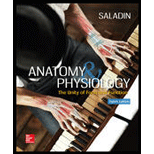
Concept explainers
The epithelium of the respiratory tract is mostly of the pseudostratified columnar ciliated type, but in the alveoli–the tiny air sacs where oxygen and carbon dioxide are exchanged between the blood and inhaled air–the epithelium is simple squamous. Explain the functional significance of this histological difference. That is, why don’t the alveoli have the same kind of epithelium as the rest of the respiratory tract?
Want to see the full answer?
Check out a sample textbook solution
Chapter 5 Solutions
Anatomy & Physiology: The Unity of Form and Function
Additional Science Textbook Solutions
Fundamentals of Anatomy & Physiology Plus Mastering A&P with eText - Access Card Package (10th Edition) (New A&P Titles by Ric Martini and Judi Nath)
Principles of Anatomy and Physiology
Microbiology with Diseases by Body System (5th Edition)
Laboratory Manual For Human Anatomy & Physiology
Laboratory Experiments in Microbiology (11th Edition)
Genetics: Analysis and Principles
- Describe the function of these terms and describe where they are located: main bronchus, trachea, alveoli.arrow_forwardIn chronic smokers, the lining of the trachea and bronchichanges from a pseudostratified ciliated columnarepithelium to a stratified squamous epithelium. Why do youthink this change occurs? What are some consequences ofthis epithelium in the trachea?arrow_forwardCertain medical conditions cause the simple squamous epithelium in the lung to thicken. Predict the consequences of this thickening?arrow_forward
- Which part of the bronchial tree contains ciliated simple columnar epithelium as seen in the photo below 1. Bronchi 2. Bronchioles 3. Respiratory bronchioles 4. Terminal bronchiolesarrow_forwardFor gas exchange to occur quickly and efficiently, which type of epithelium must be present on all respiratory surfaces? Group of answer choices Pseudostratified columnar epithelium Ciliated columnar epithelium Simple squamous epithelium Stratified squamous epithelium Ciliated squamous epitheliumarrow_forwardThe alveoli in the lungs where gas exchange occurs are composed of a simple squamous epithelium. What is thestructure of this tissue type, and how does its structure make gas exchange possible?arrow_forward
- One of the major features that distinguishes the trachea from the esophagus by histology is the 1) C-shaped hyaline cartilage 2) mucus glands 3) epithelia 4) muscle layerarrow_forwardMechanical function of the respiratory system to maintain homeostasisarrow_forwardThe Respiratory System Examine an H&E slide of a transverse section of the trachea or main bronchus, and respond to the following. 1. Give the three major layers in its wall from within outwards.i.ii.ii. 2. At high power fucus on the the apical surface of the epithelium,what structures are there? 3. What is function of the apical cell surface structures? 4. Still at a high power, how many nuclear (cell) layers can you observe? 5. Why is the epithelium called pseudostratified? 6. Look for goblet cells; what three functions do mucus produced by these cells serve?i.ii.iii. 7. Besides globlet cells, what other four types of cells are present in the epithelium?I.ii.iii.iv. 8. The epithelium is supported by a lamina priopria of loose connective tissue. Which two connective tissue fibres occur in this sub-layer?i.ii. 9. The presence of seromucous glands indicates the submucosal layer. What function is served by secretions of these glands? 10. The presence of the cartilage indicates the…arrow_forward
- The great alveolar cells secrete aphospholipid–protein mixture calledarrow_forwardTuberculosis is a disease that has become endemic in the developing world. It is a bacterial infection of end-conductive passages and respiratory passages of the lung. One of the complications of tuberculosis, even if treated, is pneumothorax. Why would pneumothorax result from an infection of the respiratory passages? How would the infection complicate the treatment of pneumothorax?arrow_forwardBoth arrows must point to the same structure in the trachea. Based on the pseudostratified epithelium. Whicharrow_forward
 Cardiopulmonary Anatomy & PhysiologyBiologyISBN:9781337794909Author:Des Jardins, Terry.Publisher:Cengage Learning,
Cardiopulmonary Anatomy & PhysiologyBiologyISBN:9781337794909Author:Des Jardins, Terry.Publisher:Cengage Learning, Concepts of BiologyBiologyISBN:9781938168116Author:Samantha Fowler, Rebecca Roush, James WisePublisher:OpenStax College
Concepts of BiologyBiologyISBN:9781938168116Author:Samantha Fowler, Rebecca Roush, James WisePublisher:OpenStax College Medical Terminology for Health Professions, Spira...Health & NutritionISBN:9781305634350Author:Ann Ehrlich, Carol L. Schroeder, Laura Ehrlich, Katrina A. SchroederPublisher:Cengage Learning
Medical Terminology for Health Professions, Spira...Health & NutritionISBN:9781305634350Author:Ann Ehrlich, Carol L. Schroeder, Laura Ehrlich, Katrina A. SchroederPublisher:Cengage Learning



